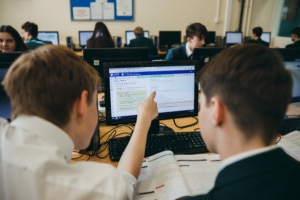Disruptive technology: What effect is this having on our students? – Mr Richardson (CHS Deputy Head)
The term ‘disruptive technology’ was coined in 1997 by Harvard professor Clayton M Christensen, who categorised new technologies as either ‘sustaining’ (those that rely on incremental changes to existing technology) or ‘disruptive’ – brand new, untried technologies that completely alter the way entire industries or populations operate.
Mr Lee Richardson, Senior Deputy Head, believes that disruptive technologies, such as mobile communications and blended learning, are already having an effect on education and that, rather than hindering creativity, technology is actually forcing teachers and students to be more creative in the way they teach and learn.

“My interest in disruptive technology is two-fold. I’m interested in it because, as educators, we’ve got to be aware of how new technologies will change the world in which our students are going to be living and working. Children coming into Year 7 this September may not be entering the world of work until around 2030. If we are not building in them the capacity to anticipate, respond to and cope with that future world of work, then we are doing them a disservice.
I’m also interested in the way that technology impacts on the education process. Ubiquitous access to digital information in the classroom has already disrupted education. Blended Learning, where the educational process involves a combination of class-based and on-line experiences, is already the new norm in many educational institutions. Sometimes this change is driven by potential cost-savings, but often it is about providing stretch and challenge, increasing flexibility and encouraging collaboration. These are qualities that employers will increasingly value. As school leaders, we have to think about how we incorporate these new opportunities into the curriculum and determine the extent to which they complement or replace traditional methods.
I feel that we may be on the cusp of a major disruptive technology in education and it could be that, in 20 years time, schools look very different to the way they do today.
We are already starting to see significant change here at CHS. One innovation that is having a major impact in some subjects is Google Classroom, a blended learning platform that allows teachers to give feedback on a student’s work in real time without even having to be in the same room as them. I observed an outstanding lesson recently, in which the teacher rarely got out of their seat and gave almost no whole-class instruction. In a traditional pedagogical model these would not be good signs! However, in this lesson, the students were working independently, multi-tasking, managing their own workload and making progress at different rates on different tasks. The technology allowed the teacher to set bespoke work packages for each student and monitor their progress by looking over their virtual shoulders at the work they were producing; making comments, offering advice and suggesting improvements. Offering feedback during the creative process is so much more powerful than doing it at the end. Students respond immediately, change the way they are working and improve the outcome. It’s a real game-changer.
Technology has certainly blurred the boundaries between school and home and has firmly dispensed with the idea that learning has to be confined to that one hour when the students are sitting in front of a teacher. Flipped lessons are becoming more common, for example. Increased use of technology means that teachers are less focused on delivering content, which is relatively easy to find, and more concerned with developing skills, which are harder to develop. In Geography, for example, a teacher will have traditionally delivered content in a lesson and then asked the class to go away and write an essay on that content. At CHS we have questioned ‘why are we spending precious lesson time giving out information that students can easily get from a website when we could be using that time to support them in writing a brilliant essay?’ So we get them to do the background reading as homework, then concentrate on the essay writing skills that they’ll need for their exams in the classroom. You do the easier stuff at home when you don’t have the support, and the trickier stuff in school when you do.

The thing about disruptive innovations is that people don’t always see them coming. In 1943, Thomas J Watson Jr of IBM famously said: “I think there is a world market for about five computers.” Bill Gates’s 1995 autobiography didn’t even mention the Internet. Even people at the cutting edge of technology couldn’t see quite how disruptive it was going to be so it is hard for a school to anticipate future technological changes. The new technologies we’re using today could be a flash in the pan or they could be the precursor to a completely disruptive innovation that will change everything, from the way students are taught to the jobs they will do. We just don’t know.
What we do know is that tomorrow’s workforce will need to be creative and flexible if they are to be successful in a time of rapid technological change. I think we owe it to our students to try and anticipate the next generation of disruptive innovations and prepare them for future ways of working. We can’t predict the future but, through embracing technology in the classroom, we can try and help our students stay one step ahead.”


